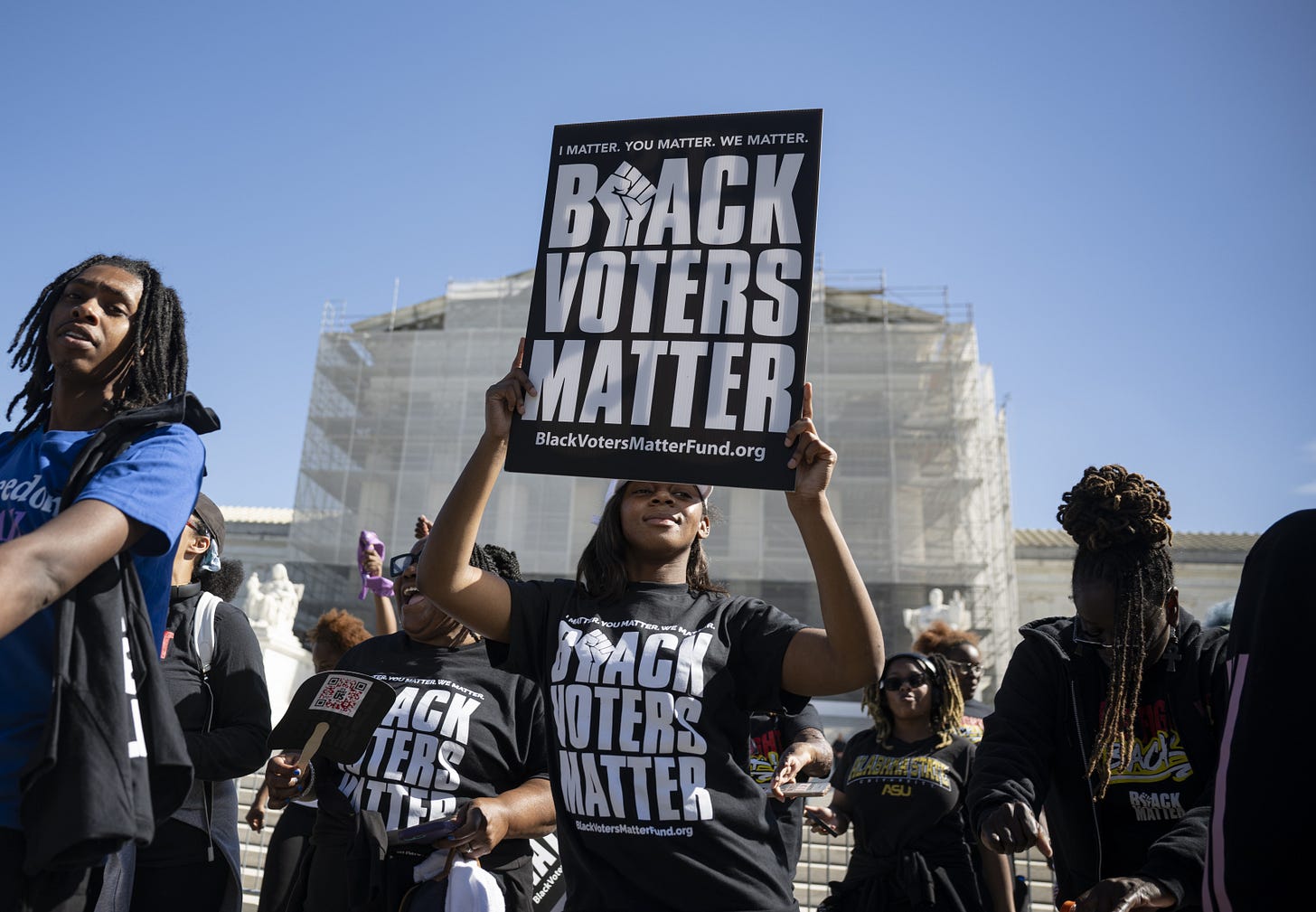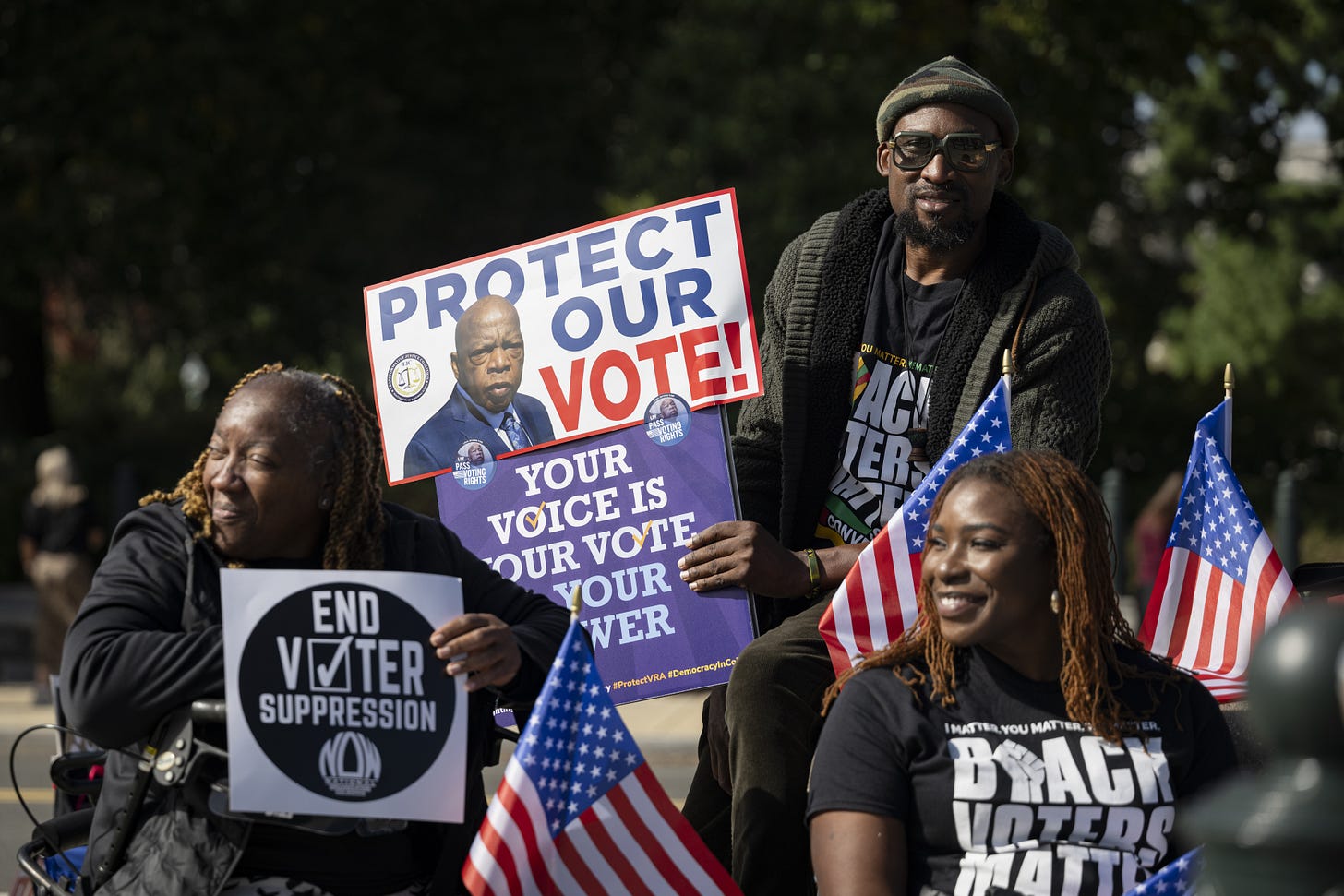The Supreme Court Case That Could End Free and Fair Elections
As Trump pressures states to redraw electoral maps to favor Republicans, the nation's far-right justices appear poised to weaken the Voting Rights Act and silence the voters it was meant to protect.

Twelve years after the Supreme Court struck down key protections in the Voting Rights Act, the justices have returned to finish the job.
On Wednesday, they re-heard Louisiana v. Callais – a case that could dismantle Section 2, the law’s main safeguard against racially discriminatory redistricting.
Questions from the bench suggest the Court’s far-right majority may be ready to strike again, dealing another blow to a law that was meant to protect the very Americans whose voices they now risk silencing.
The Supreme Court hearing came as Republicans, under pressure from Donald Trump, push to redraw congressional maps in states like Texas and Missouri – attempting to weaken the votes of Americans and shield themselves from accountability in the 2026 midterm elections.
According to a new analysis from my organization, Fair Fight Action, and the Black Voters Matter Fund, if the Court strikes it down, Republicans could gain 19 new safe US House seats. It would be enough to lock in on-party control of the House of Representatives for a generation.
This case is about power: who holds it, who’s denied it – and if Americans will still choose their representatives or those in power will decide who counts. The outcome could mark the next chapter in the Supreme Court’s decade-long effort to erode the freedom to vote – and with it, the foundation of multiracial democracy itself.
Louisiana v. Callais began as a fight for fair representation. Black residents make up roughly one-third of Louisiana’s population but, under the congressional map drawn by the state’s Republican legislature after the 2020 Census, they could elect a candidate of their choice in only one of six districts.
A federal court ruled that the map violated the Voting Rights Act and ordered a second majority-Black district to be drawn. GOP lawmakers complied – and were promptly sued by a group of self-described “non-African American” voters. They claimed that fixing the congressional map, proven to be discriminatory, was discrimination itself – simply because it considered race. A lower court eventually agreed.
Louisiana’s Republican officials appealed to the Supreme Court. They joined with the Black plaintiffs whose initial lawsuit led to the new court-ordered map being drawn – urging the Supreme Court to protect it. But the Court didn’t release a ruling. Instead, it took the extraordinary and unusual step of calling for a rehearing in its next term.
In response, Louisiana officials reversed course – now asking the justices to strike down Section 2 of the VRA entirely.
That reversal didn’t happen in a vacuum. The Court’s decision to reopen the case – combined with signals from far-right justices that they may be prepared to strike down Section 2 – sent a message to GOP officials across the country.
Louisiana received the signal and recognized the next step in the long-term Republican strategy: gutting Section 2 of the VRA and securing one-party control.
A House Permanently Controlled by Republicans
The stakes are clear and measurable. Fair Fight Action and the Black Voters Matter Fund’s new report shows overturning Section 2 could allow Republican-led legislatures to erase many of the existing competitive or minority-opportunity congressional districts across the country.
In Alabama, both minority-opportunity districts could vanish, flipping the map from two Democratic seats to seven safely Republican ones. Mississippi’s only district where Black voters can elect a candidate of their choice could disappear entirely – in the Blackest state in America. Louisiana’s new minority district could be erased, and in Texas, already home to extreme gerrymanders, voters of color could see their representation slashed from 11 districts to just three.
In practice, that means the US House could remain under permanent Republican control – not because voters chose it, but because maps were rigged to deliver that outcome.
A locked-in majority would let Trump and his allies expand their authoritarian agenda unchecked – turning federal agencies into tools of loyalty and control under Project 2025, and weaponizing government power to intimidate and attack Americans who disagree with him.
In Chicago, Trump deployed Texas National Guard troops over objections from Illinois’s governor, sending soldiers from one state enforcing his will on another. There is no crisis in Chicago that requires this – the chaos was caused by Trump’s own federal agents and their lawless assault.
ICE agents shot and killed a Chicago resident who they claimed “seriously injured” one of them. Body-cam footage showed that agent describing his injuries as “nothing major.” About 300 agents reportedly raided an apartment building, detaining residents, including children, while helicopters circled overhead. One citizen was stuffed into a van for hours without explanation while his home was ransacked.
In Memphis, Trump sent troops into a city that had reported historic declines in crime. He falsely claimed it was a crisis and called his abuse of power a “replica” of his Washington, DC, crackdown. The city’s Black Democratic mayor publicly objected, but Trump overruled local leadership and forced troops in anyway.
In Oregon, Trump’s administration tried to federalize the National Guard to confront what it falsely called “domestic terrorists” – claims that Trump-appointed Judge Karin Immergut called “untethered to facts.” In her ruling blocking the deployment, she reminded the administration that “this is a nation of Constitutional law, not martial law.”
The regime pressed ahead with federal officers firing tear gas and flash-bang grenades into peaceful crowds while drones filmed the chaos for propaganda.
Without Section 2 of the Voting Rights Act, there would be no real safeguard ensuring that the power of the American people’s votes can hold those in power to account.
From Los Angeles to Chicago and Portland, the pattern is the same: governors overruled, courts ignored, and citizens attacked. The violence is justified under the false guise of “law and order,” but its purpose is domination.
Without Section 2 of the Voting Rights Act, there would be no real safeguard ensuring that the power of the American people’s votes can hold those in power to account. When elections stop serving as a check on our elected officials, democracy’s promise becomes an illusion.
This Moment Demands Action
The path forward is narrow but real – and it depends on action. Democrats must move on two fronts: redraw maps aggressively wherever they hold power, without weakening minority representation, and make winning back Congress – especially the House – their top priority.
Regaining even one chamber would restore the ability to investigate unfair maps, expose corruption, and confront a Supreme Court that’s abandoned its duty to the Constitution.
It would also give them a vehicle to advance legislation like the Freedom to Vote Act and the John R. Lewis Voting Rights Advancement Act, measures that would restore federal voting protections and outlaw the extreme gerrymandering fueling this crisis.
Even if Trump refuses to sign such bills, forcing the confrontation would make the stakes unmistakable – showing the public that one side is still fighting for freedom, and the other is eviscerating it.
On Wednesday, as Louisiana v. Callais was reheard, protesters rallied in front of the Supreme Court, many making the journey from Southern states that took over 20 hours each way, to stand up for their right to fair representation.

The Supreme Court has shown the direction it intends to take – the rest is up to us. Democracy isn’t self-correcting; it only endures when people step forward to defend it.
Call Congress – demand they hold the Court accountable and take action to pass the John R. Lewis Voting Rights Advancement Act. Add your name to a petition and make your voice impossible to ignore.
The right to fair representation – the promise of government by the people – survives only when we refuse to surrender it.
Lauren Groh-Wargo is chief executive officer of Fair Fight Action, a Georgia-based voting rights advocacy organization, and a political strategist who managed Stacey Abrams’ campaigns for Georgia governor.
The views expressed in this article are the author’s own and do not necessarily reflect those of Zeteo.
Check out more from Zeteo:






Sadly, we can count on the fascists in black robes put the final knife into the heart of the Voting Rights Act.
Blue states are generally donor states to the federal revenue, while red states are recipient states. Democratic Senators, even in a 50/50 Senate represent 10's of millions more people. Someone needs to figure out how the most populous and most prosperous parts of the country can leverage that power to reverse the unequal representation given to red states.
This country is not close to one person one vote.